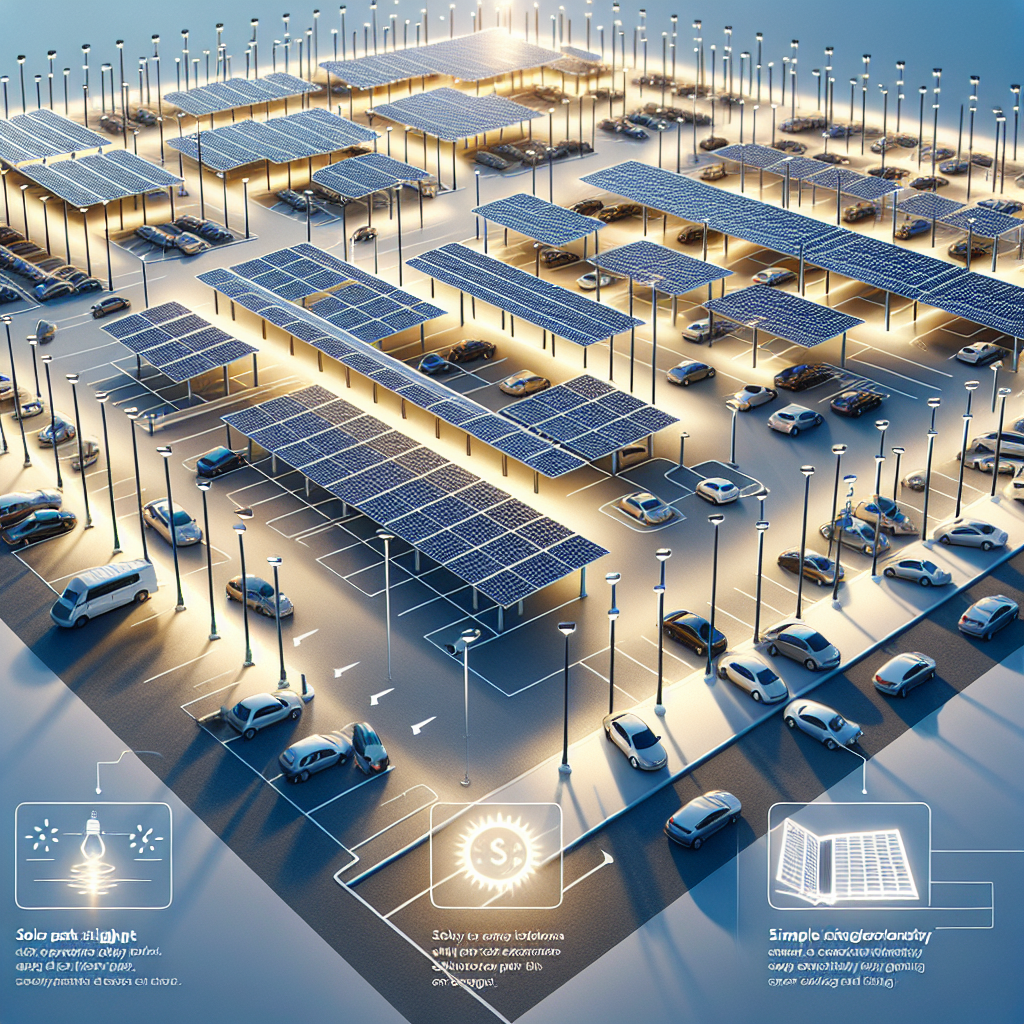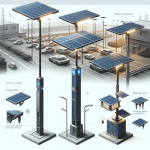Introduction to Solar Carpark Lights
Table of Contents
Introduction to Solar Carpark Lights
Solar carpark lights represent a significant advancement in sustainable and efficient outdoor lighting solutions. These lights harness solar energy through photovoltaic panels, converting sunlight into electricity to power LED fixtures. Designed to illuminate parking areas, pathways, and other outdoor spaces, solar carpark lights offer an eco-friendly alternative to traditional grid-powered lighting systems. They reduce carbon footprints, lower energy costs, and require minimal maintenance due to their self-sufficient nature. With advancements in battery storage and LED technology, solar carpark lights provide reliable, bright illumination even during cloudy days and nighttime, making them an ideal choice for enhancing safety and visibility in parking facilities.
Benefits Of Solar Carpark Lights For Sustainable Parking Solutions
Solar carpark lights represent a significant advancement in sustainable parking solutions, offering a myriad of benefits that extend beyond mere illumination. As the world increasingly shifts towards renewable energy sources, the adoption of solar-powered lighting systems in carparks is becoming more prevalent. This transition is driven by the need to reduce carbon footprints, lower operational costs, and enhance the overall efficiency of parking facilities.
One of the primary advantages of solar carpark lights is their environmental impact. Traditional lighting systems rely heavily on electricity generated from fossil fuels, contributing to greenhouse gas emissions and environmental degradation. In contrast, solar carpark lights harness energy from the sun, a renewable and inexhaustible resource. By converting sunlight into electricity through photovoltaic cells, these lights operate without emitting harmful pollutants, thereby significantly reducing the carbon footprint of parking facilities. This shift towards cleaner energy sources aligns with global efforts to combat climate change and promote environmental sustainability.
In addition to their environmental benefits, solar carpark lights offer substantial economic advantages. The initial investment in solar lighting systems may be higher compared to conventional lighting; however, the long-term savings are considerable. Solar lights eliminate the need for extensive wiring and trenching, which are often required for traditional lighting installations. This reduction in infrastructure costs, coupled with the minimal maintenance requirements of solar systems, results in significant cost savings over time. Furthermore, solar carpark lights operate independently of the grid, reducing electricity bills and providing a reliable lighting solution even during power outages.
The operational efficiency of solar carpark lights is another compelling benefit. These lights are equipped with advanced technologies such as motion sensors and timers, which optimize energy usage by adjusting the light intensity based on the presence of vehicles or pedestrians. This intelligent lighting management not only conserves energy but also enhances safety and security within the carpark. Well-lit parking areas deter criminal activities and provide a sense of security for users, thereby improving the overall user experience.
Moreover, the installation of solar carpark lights is relatively straightforward and less disruptive compared to traditional lighting systems. Since they do not require connection to the electrical grid, solar lights can be installed in remote or off-grid locations where conventional lighting would be impractical or too costly. This flexibility makes solar carpark lights an ideal solution for a wide range of applications, from urban parking lots to rural or temporary parking areas.
The aesthetic appeal of solar carpark lights should not be overlooked. Modern designs are sleek and unobtrusive, blending seamlessly with various architectural styles. This aesthetic versatility allows for the creation of visually pleasing parking environments that enhance the overall appeal of the facility. Additionally, the use of renewable energy sources can serve as a powerful statement of a company or municipality’s commitment to sustainability, potentially attracting environmentally conscious customers and stakeholders.
In conclusion, the benefits of solar carpark lights for sustainable parking solutions are multifaceted, encompassing environmental, economic, operational, and aesthetic advantages. By reducing carbon emissions, lowering operational costs, enhancing safety, and offering flexible installation options, solar carpark lights present a compelling case for their widespread adoption. As the world continues to prioritize sustainability, the integration of solar-powered lighting systems in parking facilities will undoubtedly play a crucial role in shaping a greener and more efficient future.
Key Features To Look For In Solar Carpark Lighting Systems

When considering the implementation of solar carpark lighting systems, it is essential to understand the key features that contribute to their efficiency, reliability, and overall performance. These features not only ensure optimal illumination but also enhance the sustainability and cost-effectiveness of the lighting solution. One of the primary aspects to evaluate is the quality of the solar panels. High-efficiency photovoltaic cells are crucial as they directly impact the system’s ability to convert sunlight into electrical energy. Monocrystalline panels, known for their superior efficiency and longevity, are often preferred over polycrystalline alternatives.
In addition to the solar panels, the battery storage capacity is a critical component. The batteries store the energy harnessed during the day and supply power to the lights during nighttime or cloudy conditions. Lithium-ion batteries are commonly used due to their high energy density, longer lifespan, and lower maintenance requirements compared to traditional lead-acid batteries. Ensuring that the battery capacity is sufficient to provide consistent lighting throughout the night is vital for the system’s reliability.
Another significant feature to consider is the type of light-emitting diode (LED) used in the fixtures. LEDs are favored for their energy efficiency, durability, and long operational life. The color temperature of the LEDs, measured in Kelvin (K), should be chosen based on the desired ambiance and visibility requirements. Typically, a color temperature between 4000K and 6000K is ideal for carpark lighting as it provides a bright, white light that enhances visibility and safety.
Moreover, the inclusion of smart controls and sensors can greatly enhance the functionality of solar carpark lighting systems. Motion sensors, for instance, can detect movement and adjust the lighting intensity accordingly, thereby conserving energy when the area is unoccupied. Dusk-to-dawn sensors automatically turn the lights on at sunset and off at sunrise, ensuring that the carpark is illuminated only when necessary. These smart features not only improve energy efficiency but also extend the lifespan of the lighting components.
Durability and weather resistance are also paramount when selecting solar carpark lights. The fixtures should be constructed from high-quality materials that can withstand harsh environmental conditions such as rain, wind, and extreme temperatures. An Ingress Protection (IP) rating of at least IP65 is recommended to ensure that the lights are dust-tight and protected against water jets from any direction. This level of protection guarantees that the lighting system will remain operational and maintenance-free for extended periods.
Furthermore, the design and installation flexibility of the solar carpark lighting system should not be overlooked. Modular designs that allow for easy replacement of individual components can simplify maintenance and reduce downtime. Additionally, systems that offer adjustable mounting options can accommodate various carpark layouts and ensure optimal light distribution. Properly designed lighting layouts can minimize dark spots and provide uniform illumination, enhancing both security and aesthetics.
Lastly, it is important to consider the overall cost-effectiveness of the solar carpark lighting system. While the initial investment may be higher compared to traditional lighting solutions, the long-term savings on energy bills and maintenance costs can be substantial. Evaluating the total cost of ownership, including installation, operation, and maintenance expenses, will provide a clearer picture of the system’s financial benefits.
In conclusion, selecting the right solar carpark lighting system involves careful consideration of several key features, including the quality of solar panels, battery storage capacity, LED specifications, smart controls, durability, design flexibility, and cost-effectiveness. By prioritizing these aspects, one can ensure a reliable, efficient, and sustainable lighting solution that meets the specific needs of any carpark environment.
Installation And Maintenance Tips For Solar Carpark Lights
Solar carpark lights have emerged as a sustainable and cost-effective solution for illuminating parking areas. Their installation and maintenance, however, require careful consideration to ensure optimal performance and longevity. This article provides essential tips for the installation and maintenance of solar carpark lights, guiding you through the process with a focus on efficiency and durability.
To begin with, the installation of solar carpark lights necessitates a thorough site assessment. It is crucial to identify locations that receive ample sunlight throughout the day, as the efficiency of solar panels directly depends on their exposure to sunlight. Shaded areas or locations with frequent obstructions should be avoided to prevent suboptimal charging of the solar batteries. Additionally, the orientation of the solar panels should be such that they face the sun for the maximum duration possible, typically towards the equator.
Once the ideal locations are identified, the next step involves the actual installation of the lights. It is advisable to follow the manufacturer’s guidelines meticulously to ensure proper setup. The mounting height of the lights should be determined based on the area that needs to be illuminated. Generally, a height of 10 to 15 feet is recommended for carpark lights to provide adequate coverage. Furthermore, the lights should be securely fastened to withstand adverse weather conditions, such as strong winds or heavy rain.
Transitioning to the electrical components, it is essential to ensure that all connections are secure and weatherproof. The wiring should be insulated and protected from potential damage caused by environmental factors. It is also important to check the battery connections and ensure that they are properly sealed to prevent moisture ingress, which could lead to corrosion and reduced battery life. Regular inspection of these components can help in identifying and rectifying any issues before they escalate.
In terms of maintenance, solar carpark lights are relatively low-maintenance compared to traditional lighting systems. However, periodic checks and cleaning are necessary to maintain their efficiency. The solar panels should be cleaned regularly to remove dust, bird droppings, and other debris that may obstruct sunlight absorption. A soft cloth and mild detergent can be used for this purpose, ensuring that the panels are not scratched or damaged during the cleaning process.
Moreover, it is important to monitor the performance of the batteries. Over time, batteries may lose their capacity to hold a charge, necessitating replacement. It is advisable to follow the manufacturer’s recommendations regarding battery life and replacement intervals. Additionally, checking the light output periodically can help in identifying any issues with the LED bulbs or other components. If the light output diminishes significantly, it may indicate a need for component replacement or further inspection.
Furthermore, it is beneficial to keep a maintenance log to track the performance and any issues encountered with the solar carpark lights. This log can serve as a valuable reference for future maintenance activities and help in identifying recurring problems that may require more comprehensive solutions.
In conclusion, the installation and maintenance of solar carpark lights involve several critical steps that ensure their optimal performance and longevity. By conducting a thorough site assessment, following proper installation procedures, and performing regular maintenance checks, one can maximize the benefits of these sustainable lighting solutions. As solar technology continues to advance, adhering to these best practices will ensure that solar carpark lights remain a reliable and efficient choice for illuminating parking areas.
Read more about Solar Carpark Lights:
- Types of Solar Carpark Lights
- Factors to Consider when Choosing Solar Carpark Lights
- Installation and Maintenance of Solar Carpark Lights
- Top Brands in the Solar Carpark Light Industry
- Innovative Features of Solar Carpark Lights
- Case Studies: Successful Implementation of Solar Carpark Lights
- Practical Applications of Solar Carpark Lights
- Future Developments in Solar Carpark Lights
- Frequently Asked Questions about Solar Carpark Lights









